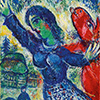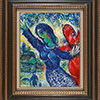PROVENANCE:
Bernard Boussenot, France
Private collection, Asia
This painting is sold with a certificate of authenticity issued by the artist’s son David Mac Neil.
Catalogue Note:
FEMME BLEUE, ÂNE ROUGE
In 1969, construction began on the Musée Marc Chagall in Nice. His reputation was high at the time and his artistic accomplishment outstanding, having also caught the attention and praise of the French government. That year he painted Femme Bleue, Âne Rouge, as his previous convention, the colors are vivid. Animals are red, the face is green and the woman's body is blue against a background of rural farmland. In the foreground, a woman appears to fly with an animal as if in a dr eam, colorfully festive and joyful. Chagall likes flying in his paintings, as it brings a sense of stability in the absence of gravity. A fantastic imagination of the self is a signature expression of surrealist painters.
Animals in the paintings of Chagall tend to have gigantic proportions within the frame. The arresting arrangement coupled with exaggerated colors brings out the importance of animals in his paintings. This also reflects the hardship of the artist's Jewish upbringing as man's existence depends on the sacrifice of animals. When Chagall fixed his gaze on the animal in the painting, as he has done in painting the donkey red, it is a projection of his inner sentiment. You can also see in the looking back of the donkey a kind of reflection, as the donkey fixes a wide eye on the painter .
Critics feel that the charm of Chagall's painting surpasses the limitations of human inspiration. The floating, flying and jumping in his painting symbolize escape from the constraints of reality. He brings powerful poetic reserves to the canvas and his subjects are resplendent in the bold vitality of life, as if the images in th e painting are dreaming, expressing human longing for joy and happiness. Whether the unrealistic blue-haired woman or red donkey, they are mysterious visual traps deliberately set by the artist. When we focus on the screen, spiritual analysis, acceptance and adjustment enables the viewer to also experience the scene in the painting, experience the passion and imagination created by the artist, like the beauty of reading poetry. This is why countless viewers have been drawn to and fascinated by Chagall's paintings, r eveling amongst them.
On July 7th of 1887, Marc Chagall was born into a Jewish family in a Russian farming village. He was the eldest son of ten children in a poor family. His mother encouraged him along the path of art, sending him to St. Petersburg to study. In 1910 he traveled to Paris where he met Robert Delaunay, Fernand Léger and other avantgarde artists. After the close of the war in 1920 he returned to Paris to become a surrealist painter.
Though Chagall's paintings convey love and good fortune, his life story is one of poverty, war, Jewish persecution and the death of loved ones. He transformed his pain into love and dreams. In 1914, as Europe was on the brink of the First World War, he left Paris to return to Russia, only to go back to Paris eight years later. In his hometown during the war, he meets and marries the daughter of a wealthy family, Bella Rosenfield. He falls in love with the elegant and cultured girl at first sight. Bella's love became an important source of creativity for Chagall and her beauty is his inspiring muse throughout his life. In 1944, Bella's passing at the age of 58 hit him hard. In 1952, at the age of 65, Chagall marries again to a Russian woman, Valentina Brodsky, nicknamed Vava, who accompanies him to the end of his life.
Chagall's work is figurative with poetic imagination. His art is resplendent with love and memories of his country home. Sometime s he creates a religious story to convey the sense of a narration or fable. His art emanates from his hometown in Russia, stretching to the whole of Europe, and even to the United States and Asia. Chagall's artwork has the meaning of indoctrination and they are quite prized by art collectors around the world. Having traveled to many places throughout his life, his personal image and his art perfectly capture the essence of a visitor from afar.
After Marc Chagall became famous, his work was acquired by galleries, museums and collectors, including work on paper, prints, stage design and costumes in addition to his oil paintings. But he also loved public art, such as stained glass, hoping that the public might have the opportunity to appreciate his work. Some of his later well-known works include stained glass windows for the synagogue of Hebrew University's Hadassah Medical Center in Jerusalem (1961), the dome ceiling of the Opéra national de Paris-Palais Garnier (1964) and murals for the New York Metropolitan Opera. In March of 1985 he passed away in Saint-Paul-de-Vence in southern France, having enjoyed a rich life of 98 years. He once said, Only love interests me, and I am only in contact with things that revolve around love. The art of his life drew a beautiful canvas, depicting numerous innocent love stories and dreams, his work conveying the warmest and softest love of the human heart.


